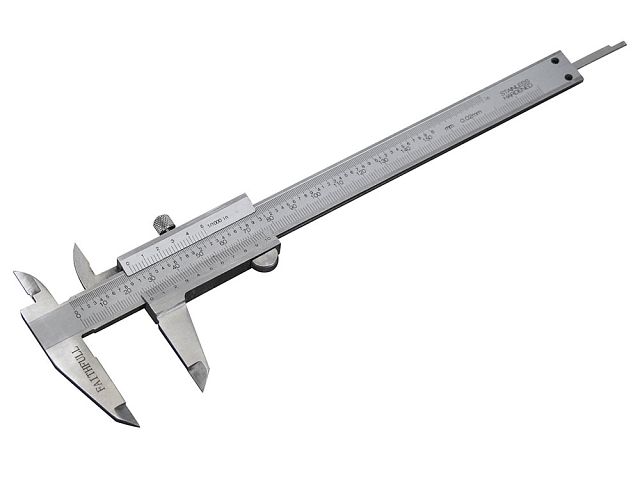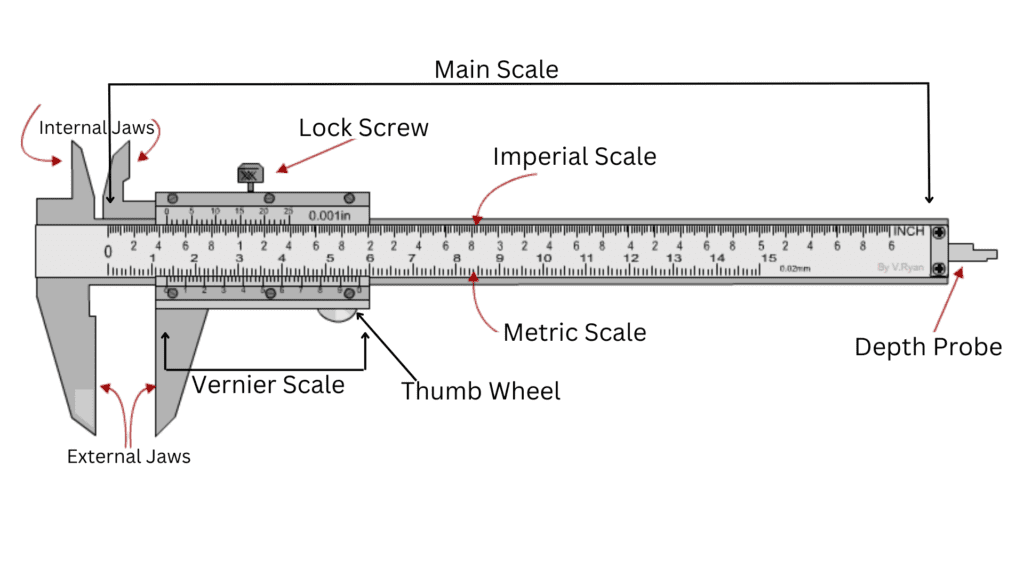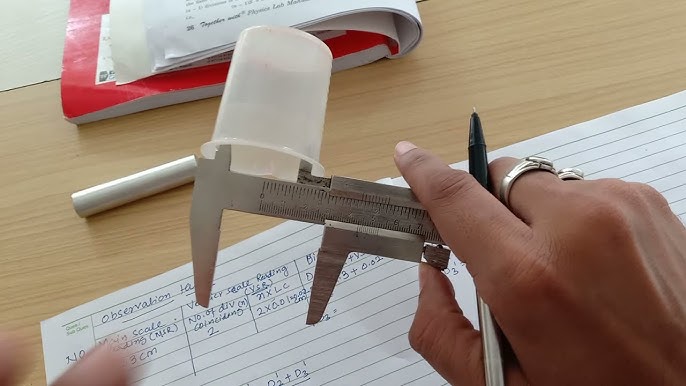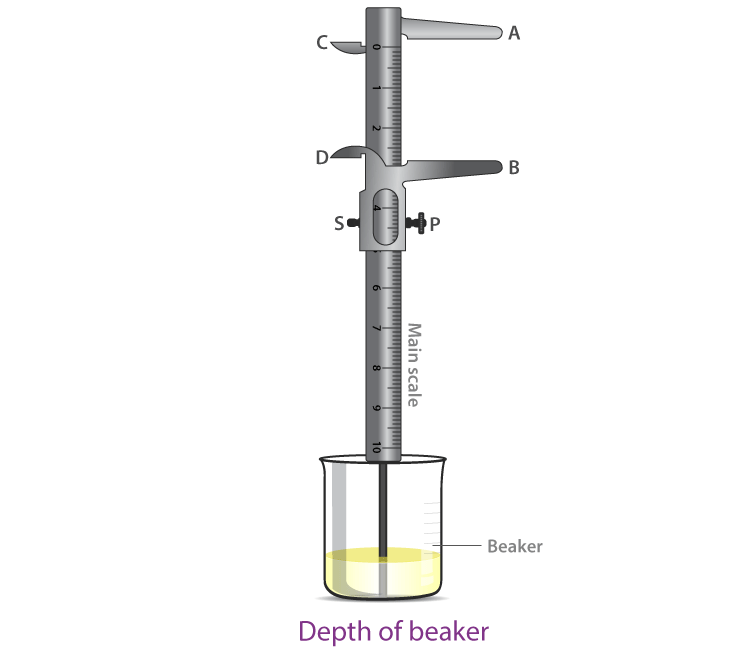
How to Use Vernier Calipers: A Comprehensive Guide for Accurate Measurements
Vernier calipers are must-have tools for anyone who needs precise measurements, whether it’s External, Internal, or even the depth of objects.
They’re good for professional engineers, DIY hobbyists, and students learning about measurements. In this guide, we’ll show you how to use vernier calipers step-by-step, explain the different parts, and give you some tips to get accurate results every time with this amazing device
What are Vernier Calipers ?
Vernier calipers are a measuring device used for measuring dimensions with high accuracy. First and foremost, They have two sets of jaws for internal and external measurements, and a depth probe.
Additionally the main scale provides the main measurement, while the Vernier scale slides along the main scale to give precise reading between the main scale’s marks. To use them, align the jaws with the object and read the value from where the scales match up.
Vernier Caliper Parts and Functions
A Vernier caliper consists of a few key parts: the main scale, vernier scale, jaws for measuring external and internal dimensions, and a depth probe for measuring depths. Furthermore it also includes a handy locking screw to keep your measurements secure. Before you learn how to use Vernier Calipers, To begin with check below the important parts and their usages.
- Main Scale: This fixed ruler provides the main measurement.
- Vernier Scale: It slides along the main scale to give precise readings between the main scale’s marks.
- External Jaws: Used to measure the external dimensions of objects.
- Internal Jaws: Used for measuring internal dimensions like the inside of a pipe or hole.
- Depth Probe: A slender rod extending from the bottom for measuring depths of holes or grooves.
- Lock Screw: This secures the Vernier scale in place once measurements are set.
- Thumb Wheel: Allows for smooth and controlled movement of the Vernier scale to achieve accurate measurements.

What Are The Uses Of Vernier Caliper ?
Vernier calipers are a versatile tools used in a wide range of fields for precise measurements:
- Mechanical Engineering: Perfect for measuring machine part dimensions with accuracy.
- Manufacturing: Essential in quality control to ensure parts meet exact specifications.
- DIY Projects: Great for achieving precise fits when working on your projects.
- Educational Purposes: They’re also fantastic for teaching students the importance of measuring things accurately.
How to use vernier caliper step by step!
Below are a few straight forward steps for accurate measurements
Step 1: Calipers at Zero
First and foremost before any measurement, make sure that the calipers are set at zero:
- Close the Jaws: Bring both the fixed and sliding jaws together completely.
- Check the Zero mark: Ensure the zero on the main scale and the Vernier scale is align together properly, if not then adjust the zero setting or note the deviation for correction.

Step 2: Measure External Dimensions

Additionally, it is done through the External Jaws of Vernier Caliper (For example – the outer diameter of a washer)
- Open the External Jaws: Slide the jaws apart and place the object between the jaws
- Close the Jaws: Close the jaws gently until the object is held.
- Read the main scale: Note the reading at the main scale just before on the zero mark on the vernier scale
- Read the Vernier Scale: Find the line on the vernier scale that align best on the main scale. This will tell the decimal value of the object.
- Measurement calculation: Add the main scale reading and the vernier scale reading for the total measurement.
The Image shows the reading on main scale just before the zero mark on the vernier scale as 23 and the the line on the vernier scale that align best on the main scale is 6 so the reading will be as 23.6
Step 3: Measure Internal Dimensions
On the other hand it is done through the Internal Jaws of the vernier caliper (E.g. Measuring the inside diameter of the washer)
- Use the Inside Jaws: To measure the object, place the smaller jaws inside the object.
- Expand the Jaws: Expand the jaws until it touches the object from inside
- Read the main and vernier scale: Read the main and vernier scale as we did in the external dimension measurement
Look at the image for better reference

Step 4: Measure Depth

To measure the depth of a hole or any object.
- Extend the Depth Rod: Place the end of the calipers on the surface with the rod extending into the hole.
- Read the Scales: As with other measurements, read the main and vernier scales to find the depth.
Step 5: Measure Step Dimensions
To measure step dimensions (e.g., the distance between two levels on an object)
- Use the Step Measurement Function: Place the caliper’s fixed jaw on one step and extend the sliding jaw to the other step
- Read the Scales: Obtain the step measurement using the main scale and the Vernier scale.
A Few Tips for Accurate Measurements
Meanwhile after understanding how to use vernier calipers. You can keep the following things in mind to ensure precision:
- Maintain Cleanliness: Check if your vernier caliper is clean and away from any dust, oil or debris. You can use Pidilite WD-40 Spray to clean your vernier caliper
- Read at Eye level: Look at the vernier at eye level to avoid parallax error
- Apply Gentle pressure: Don’t apply excess pressure to the jaws which can distort the object or calipers
- Store properly: Generally vernier calipers come with a plastic box. It is recommended to keep it in the box when not in use.
A few Of The Most Frequently Asked Questions About Vernier Calipers After Understading How To Use Vernier Calipers Are As Below:
- How to choose a vernier caliper?
- What type of caliper is most accurate?
- How to Calibrate Vernier Calipers?
- Which are the Best Vernier Calipers?
- What is the Zero Error of a Vernier Caliper?
- What is the difference between Vernier Calipers vs Micrometer?
How to Choose A Vernier Caliper ?
It involves several factors to ensure that it meets your requirements
1. Type of Vernier caliper
Manual Vernier Caliper: Requires reading the scale manually

Dial Calipers: It has a dial for easier reading as shown in the image

Digital Caliper: An electronic screen which is very easy to read

2. Measurement Range
Generally the ranges are 0-150 mm (6 inches), 0-200 mm (8 inches), and 0-300 mm (12 inches). Choose accordingly
3. Accuracy and precision
Common precision levels include ±0.02 mm and ±0.01 mm.
4. Features:
Some of the digital calipers comes with below features which can help to make your work easy.
- Conversion between Units
- Zero Setting at any position
- Auto off function to save battery
- Data transfer to computer
5. Brands and warranty
Moreover there are many local brands which are available in the market. But we would suggest you to go for renowned brands like Mitutoyo , Insize.
6. Price
Prices can vary significantly based on the type, range, brand, and other features of vernier calipers
What Type Of Caliper Is Most Accurate?
Consequently digital Calipers are most accurate type of vernier calipers because of the following reasons.
- They show direct numerical readout and eliminate the possibility of human error
- They have higher resolution as compared to manual or dial calipers
- They can be zeroed at any point, allowing for differential measurements and greater flexibility
In contrast even though they are most accurate but it comes with the high cost. Digital calipers are more expensive than other vernier calipers
How to Calibrate Vernier Calipers?
Subsequently, calibration involves several steps and tools to ensure accuracy
Step | Description | Tools Needed |
1. Clean the Caliper | Wipe surfaces clean. | Lint-free cloth |
2. Check Zero Error | Close jaws, check zero alignment, adjust if needed. | Caliper |
3. Measure Known Standards | Check with gauge blocks or precision standards. | Gauge blocks |
4. Internal Jaws Calibration | Measure internal diameter of a gauge block. | Gauge blocks |
5. External Jaws Calibration | Measure external width of a gauge block. | Gauge blocks |
6. Depth Rod Calibration | Measure depth with the depth rod. | Depth gauge block |
7. Step Measurement Calibration | Measure steps on a gauge block. | Step gauge |
8. Record Measurements | Document and compare measurements to standards. | Calibration log |
9. Adjust Calibration | Adjust zero if necessary. | Caliper adjustment tools |
10. Repeat Measurements | Re-check measurements after adjustments. | Gauge blocks, ring gauges |
11. Documentation | Record calibration process and results. | Calibration log |
Which are the Best Vernier Calipers?
According to economic times below are the 9 best vernier Calipers in india for precision in measurement and metrology
| Brand & Model | Type | Accuracy |
| Mitutoyo 530-118 Vernier Caliper | Manual Vernier | ±0.02 mm |
| Insize 1108200 Electronic Caliper | Digital | ±0.02 mm |
| Yuzukitm Vernier Caliper | Manual Vernier | ±0.02 mm |
| zhart Vernier Caliper Digital | Digital | ±0.02 mm |
| ESAW Vernier Caliper Screw Gauge Set | Manual Vernier | ±0.02 mm |
| SKADIOO Electronic Digital Caliper | Digital | ±0.02 mm |
| ESAW Vernier Caliper with Fine Wheel | Manual Vernier | ±0.02 mm |
| Comet Vernier Caliper | Manual Vernier | ±0.02 mm |
| Labworld Matt Vernier Caliper | Manual Vernier | ±0.02 mm |
| 10. Repeat Measurements | Re-check measurements after adjustments. | Gauge blocks, ring gauges |
| 11. Documentation | Record calibration process and results. | Calibration log |
- Mitutoyo 530-118 Vernier Calipers See price
- Insize 1108200 Electronic Vernier Calipers See price
- Yuzukitm Vernier Caliper See price
- zhart Vernier Caliper Digital See price
- ESAW Vernier Caliper Screw Gauge Set
- SKADIOO Electronic Digital Caliper with carry box
- ESAW Vernier Caliper with Fine Wheel Measurement
- Comet Vernier Caliper
- Labworld Matt Vernier Caliper
What is the Zero Error of a Vernier Caliper?
Zero error is defined as the condition where a measuring instrument displays a reading when it should read zero. In the case of vernier calipers, zero error occurs when the zero on the main scale does not coincide with the zero on the vernier scale.
What Is The Difference Between Vernier Calipers Vs Micrometer?
Micrometers are specialized for precise measurements of small objects, offering high accuracy and fine resolution. In contrast, vernier calipers provide a wider range of measurement capabilities and are generally easier to use. The choice between these tools hinges on the specific requirements of the measurement task and the desired level of precision. Check below table for better clarifications.
| Feature | Vernier Calipers | Micrometer |
| Type | Typically manual (also available in digital forms) | Generally manual (also available in digital forms) |
| Measurement Range | Typically up to 300 mm (12 inches) | Usually up to 25 mm (1 inch) |
| Accuracy | ±0.02 mm to ±0.05 mm | ±0.002 mm to ±0.005 mm |
| Resolution | 0.02 mm to 0.05 mm | 0.001 mm |
| Usage | Measures outer dimensions, inner dimensions, depth | Measures outer dimensions with high precision |
| Reading Mechanism | Vernier scale or digital display | Screw and spindle mechanism, digital display (if digital) |
| Application | General purpose, versatile | Precision machining, engineering, and manufacturing |
| Material | Stainless steel | Carbide, steel, or other hardened materials |
| Features | Dual scale (metric and imperial), depth gauge, step measurement | Ratchet stop for consistent measurement pressure, thimble for fine adjustment |
| Cost | Lower cost | Higher cost |
Conclusion
Mastering how to use vernier calipers opens up a world of precision measurement. Whether you’re measuring the width of a component, the diameter of a hole, or the depth of a recess, vernier calipers provide unparalleled accuracy. For any industrial tools, you can check our website www.procuredeals.in.
